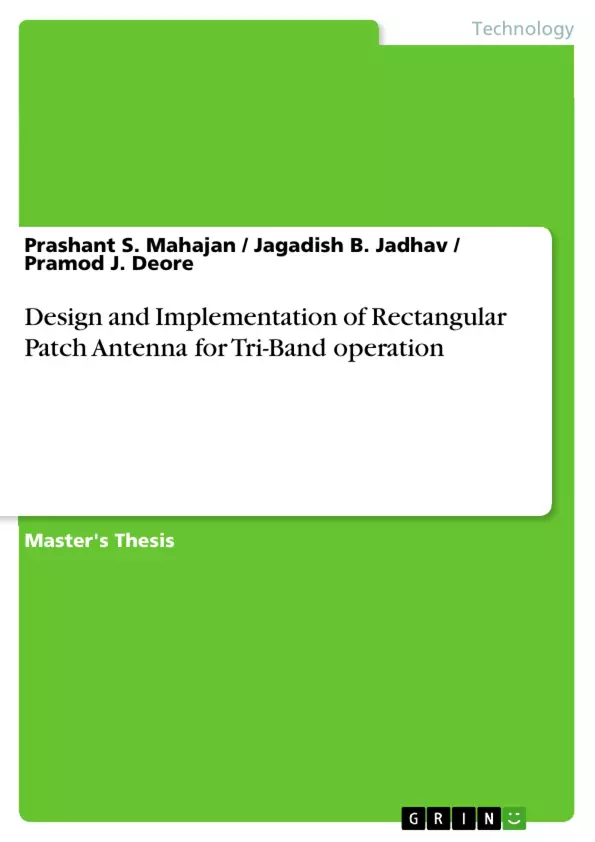In today's modern communication industry, antennas are the most important components required to create a communication link. Microstrip antennas are the most suited for aerospace and mobile applications because of their low profile, light weight and low power handling capacity. These antennas can be designed in a variety of shapes in order to obtain enhanced gain and bandwidth for dual band and tri-band operation. This book focus on a detailed study of how to design and simulate a microstrip fed rectangular patch antenna using IE3D software with effect of antenna dimensions length ( L ), width ( W ), relative dielectric constant , substrate thickness (t ) on the radiation parameters of bandwidth and gain. The design parameters of the antenna calculated using the transmission line model. Here antenna operates for tri- band operation, the operating bands are GSM , PCA and UTMS for antenna geometry -I and WLAN and WiMAX for antenna geometry -II. The fractional bandwidths (FB) after simulation obtain under criterion ( S_11 < -10 dB) are 6.45% for GSM [890-960 MHz], 4.25% for WLAN [2.40 - 2.51 GHz], 6.89% for PCA [1850-1990 MHz], 11.42 % for WiMAX [3.35 - 3.94 GHz], 9.09% for UTMS [1920-2170 MHz] and 18.18% for WLAN [5.02 - 6.63 GHz] and peak gain 2.43 dBi at 5.36 GHz.
Inhaltsverzeichnis (Table of Contents)
- Introduction
- Introduction
- Feed technique
- Microstrip feed line
- Coaxial feed line
- Aperture coupled feed
- Proximity couple feed line
- Literature survey
- Problem definition
- Objective of the book
- Transmission line model
- Fringing effects
- Effective length, resonant frequency and effective width
- Design
- Design procedure
- Conductance
- Resonant input resistance
- Design patch for tri-band operation
- Antenna geometry I
- Mathematical calculations of antenna geometry I
- Antenna geometry - II
- Mathematical calculations of antenna geometry II
- Result and discussion
- Antenna geometry I
- Return loss
- Voltage standing wave ratio (VSWR)
- Current distribution
- Radiation pattern.
- Antenna geometry II
- Return loss
- Voltage standing wave ratio (VSWR)
- Radiation pattern.
- Gain . .
- Current distribution
- Comparison of antenna geometry
- Conclusion
- Scope for improvement
Zielsetzung und Themenschwerpunkte (Objectives and Key Themes)
This book explores the design and analysis of microstrip patch antennas for tri-band operation. It aims to provide a comprehensive understanding of the principles, techniques, and challenges involved in achieving tri-band operation in microstrip patch antennas. The text focuses on practical design considerations and utilizes simulation software to validate the design process.- Microstrip Patch Antenna Design
- Tri-band Operation
- Transmission Line Model and Analysis
- Simulation and Validation
- Practical Design Considerations
Zusammenfassung der Kapitel (Chapter Summaries)
- Introduction: This chapter introduces the concept of microstrip patch antennas and provides an overview of their applications and advantages. It also discusses various feed techniques commonly used in patch antenna design.
- Literature survey: This chapter presents a comprehensive review of existing research and development in the field of microstrip patch antennas, particularly focusing on tri-band operation.
- Problem definition: This chapter outlines the specific challenges and objectives addressed by the book. It defines the problem of achieving tri-band operation in microstrip patch antennas and highlights the key issues that need to be tackled.
- Objective of the book: This chapter states the primary goals and objectives of the book. It outlines the intended outcomes and the knowledge and skills that readers are expected to gain upon completing the book.
- Transmission line model: This chapter delves into the theoretical foundation of microstrip patch antenna design, focusing on the transmission line model. It discusses the concepts of fringing effects, effective length, resonant frequency, and effective width. It also explains the design procedure for microstrip patch antennas based on this model.
- Design patch for tri-band operation: This chapter presents the practical design of microstrip patch antennas for achieving tri-band operation. It explores different antenna geometries and provides detailed mathematical calculations for optimizing the design parameters.
- Result and discussion: This chapter presents the simulation results and analysis of the designed microstrip patch antennas. It discusses the performance characteristics, such as return loss, VSWR, current distribution, and radiation patterns, for different antenna geometries.
- Comparison of antenna geometry: This chapter compares the performance of different antenna geometries designed for tri-band operation, highlighting their advantages and disadvantages.
Schlüsselwörter (Keywords)
This book focuses on the design and analysis of microstrip patch antennas for tri-band operation, utilizing transmission line model and simulation software. It explores practical design considerations, simulation results, and performance characteristics of different antenna geometries. Key terms include microstrip patch antenna, tri-band operation, transmission line model, simulation, design considerations, return loss, VSWR, current distribution, and radiation pattern.- Citar trabajo
- Prashant S. Mahajan (Autor), Jagadish B. Jadhav (Autor), Dr. Pramod J. Deore (Autor), 2013, Design and Implementation of Rectangular Patch Antenna for Tri-Band operation, Múnich, GRIN Verlag, https://www.grin.com/document/295831



